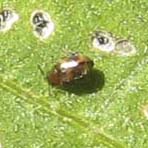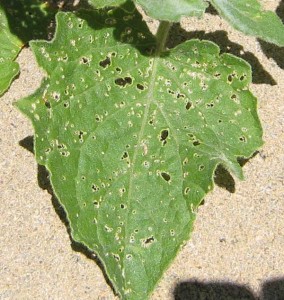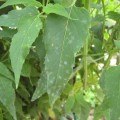Flea beetles, part of the Chrysomelidae family,are tiny black or brown-bronze beetles that jump like a flea, and leave tiny holes or divots in the leaves. They seem to especially love eggplant leaves. Fruits, like eggplant, also get damaged with scarring from the flea beetles feeding. Productivity is also reduced because they love the new leaves, growing tips and flower buds. Since they are also a disease vector of some serious diseases, like bacterial wilt and early blight, they are important to keep in control.
Physical Description
Small black beetles that jump rapidly when disturbed. Long back legs make them able to jump like fleas. They come in different colors: shiny black, reddish brown, bronze, yellow-brown. They range from 1/16 of an inch to 1/2 inch long.
Life Cycle
Adult flea beetles survive the winter in crop debris, weeds, or adjacent fields or meadows. They make their appearance in spring to feed for a few weeks before laying eggs, then die soon after. The eggs are laid at the base of their favorite host plants, where they hatch about 1 week later. The larvae then burrow through the soil, feeding on roots, doing only minor damage, although potatoes do get a crackled-skin look to them from the larvae feeding on them. This larval stage lasts about 3 weeks. The larvae are slender white grubs with brown heads and can get up to 3/4 inch long. The pupal stage lasts about 2 weeks before the the adult emerges.
In the south there is time for several generations, whereas the northern gardeners only have to deal with two.
Flea beetles are especially bad when you have calm, warm spring weather, but they don’t do well when there are fluctuating temperatures and sporadic rain showers.
Plants Affected
- all seedlings
- leafy greens like arugula, mustard, spinach
- cabbage family
- beets
- potatoes
- sweet potatoes
- eggplants
- tomatoes
- peppers (not a serious pest of peppers, except on very young plants)
- corn
- basil
- turnips
- radishes
Range
Flea beetles can be found worldwide.
Symptoms
Whole Plant
- young seedlings can be weakened or killed
Leaves
-
many small holes in leaves (shotholes)
Fruit
- scars or catfacing appears where flea beetles have fed
Roots
Tubers
- flea beetle larvae feeding produces a rough surface on tubers, covered with tiny cracks.
How to Positively Identify
Tiny holes found on leaves with tiny black or brownish beetles present. May be in small numbers, even though there’s lots of damage. The tiny beetle jumps when disturbed.
Prevention & Control
Cultural Controls
- Cover crops
- Timing: flea beetles emerge at about the same time each year in the spring. If you can time setting out your seedlings to when the first generation of flea beetles dies off, then your seedlings will have a good chance of surviving. By the time the second generation emerges, the seedlings should be established enough to survive an attack.
- Interplanting or Living Mulches: some sources recommend planting clover under your main crop to make it harder for the flea beetles to find your vegetables. They love the clover, so they get sidetracked.
- Row Covers: if you can cover the area right after planting, and you are sure there aren’t already flea beetles present, then a row cover is an excellent barrier.Leave the row cover on until it’s time for pollination.
- Sticky Paper: they recommend not mounting sticky paper, but just holding it next to the plant while you brush it to make the flea beetles jump off the plant and onto the sticky paper. This way beneficial bugs and pollinators don’t get caught in the sticky paper. White or Yellow sticky paper may be used.
- Vacuuming: use a hand-held vacuum to suck adult flea beetles off your plants daily. You should see a decline in populations and very few will be getting to the age where they can reproduce.
- Watering: keep seedlings and transplants well watered to avoid stress, which is when they are most vulnerable to flea beetle damage.
- Garden Hygiene: Remove crop debris and weeds so that flea beetles have no place to overwinter.
- Organic Fertilization: some literature suggests that organic fertilization may deter flea beetles
- Crop Rotation: because flea beetles are so mobile, and because there are so many species of flea beetles, crop rotation doesn’t do much good.
- Catnip: anecdotal reports that catnip may repel flea beetles has failed to be succesfully confirmed in trials.
Natural Enemies & Biological Controls
- Beauveria bassiana (spinosad) may kill of flea beetles, but repeat sprays will probably be needed.
- Braconid wasp (Microcotonus vittage Muesebeck) kills adult flea beetles and sterilizes the females.
- Beneficial nematodes, entomopathogenic nematodes, are effective at controlling flea beetles because they eat the flea beetle larvae while they are in the soil
- Big-Eyed Bugs (Geocoris spp of the Lygaeid family) love to eat many pests, such as flea beetles, spider mites, insect eggs and small caterpillars. They are attracted by growing cool-season cover crops like berseem clover (Trifolium alexandrium) and can be found on common knotweed.
Trap Crops
- How they work: since flea beetles are drawn to many cabbage-family crops, especially napa cabbages and daikon radishes, you can utilize these to trap flea beetles a week or two before planting your main crop. The idea is to pull up the trap crops to kill the adult flea beetles without letting them reproduce. Pulling out the trap crop plants one-by-one, as they get attacked by the adults. When you go some time without more flea beetles emerging, then you plant your main crop.
- Good trap crops for flea beetles:
- Chinese Southern Giant Mustard
- Napa Cabbages
- Daikon Radishes (‘Chinese Daikon’)
- ‘Snow Belle’ Radish
- Arugula
Sprays or Dusts
Note: since most of these sprays and dusts are broad-spectrum pesticides, they should be used as a last resort only. Killing off the beneficial insects can allow other pests to flourish
- Catnip spray: anecdotal reports that catnip may repel flea beetles has failed to be succesfully confirmed in trials.
- Diatomaceous Earth – kills adults and surface-dwelling larvae
- Kaolin Clay – deters feeding, but has also been found to reduce fruit yield and quality
- Garlic spray – deters feeding, but efficacy seems to decline later in the season
- Onion spray – deters feeding
- Mint spray – deters feeding
- Spinosad (Beauveria bassiana) – kills flea beetles
- Insecticidal soap not very effective against flea beetles
- Botanical Pesticides:
- neem
- rotenone
- pyrethrin
- sagadilla
Treatment
Here’s what I’m doing for my flea beetle infestation:
- Beneficial Nematodes – will be sprinkled, along with compost, around all of the plants
- Diatomaceous Earth – will be sprinkled on the leaf surfaces and on top of the straw mulch
- Vacuuming – daily vacuuming of leaf surfaces




